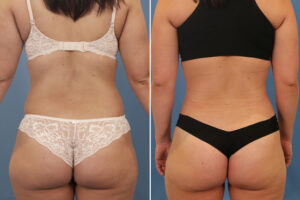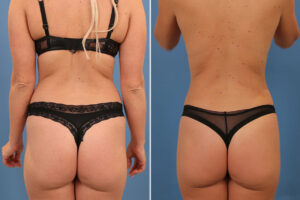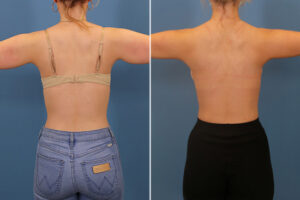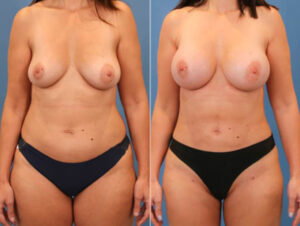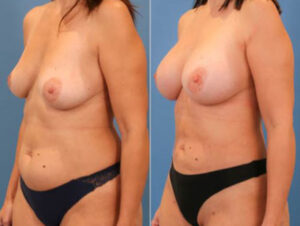HOW IS LIPOSUCTION PERFORMED?
Liposuction is usually performed under a general anaesthetic in a hospital setting. During the procedure, local anaesthetic fluid is also used, and fat is removed through small incisions, typically around 5mm in size.
After surgery, patients are generally advised to wear a compression garment. This can help reduce swelling and support healing by limiting fluid build-up under the skin.
WHAT ARE THE MAIN AREAS FOR LIPOSUCTION?
FLANKS
The waist and flanks are common areas for liposuction. For many patients, getting rid of flanks via diet and exercise alone can be incredibly difficult. Liposuction here can help patients see great results, especially when they have reasonable-to-excellent skin elasticity.
UPPER ARMS
The upper arm is something that can affect men and women, but it is particularly common in women as they age. Even if you’re not overweight, it is possible to have an unpleasant “arm jiggle” due to lack of muscle tone. Liposuction can help smooth and tighten the area for a firmer appearance.
ABDOMEN
Plastic surgeons often divide the abdomen into “upper” and “lower” regions that may be treated separately. The lower region is responsible for the dreaded “muffin top,” which makes it a popular place for liposuction. The upper region is the area between your belly button and ribs, which can also stubbornly hold onto a layer of fat. Liposuction in these regions can help patients achieve a slimmer, sleeker profile.
RENUVION
For many women, having smooth, shapely hips can be important, women often undergo liposuction here to remove excess deposits of fat.
FREQUENTLY ASKED QUESTIONS ABOUT OUR LIPOSUCTION PROCEDURE
If pre- and post-operative images are shown on this site, they are provided for general information only and do not predict your outcome. Images are displayed using comparable lighting, positioning, background, and clothing where possible. Any gallery contains a prominent notice stating that results vary due to factors including individual anatomy and healing. Images are not digitally altered other than standard anonymisation and sizing for web display.
Dr Alex Phoon Specialist Plastic Surgeon
AHPRA registration number: MED0001587102
Registration type: Specialist registration
Recognised specialty: Plastic & Reconstructive Surgery
Patients may verify registration via the AHPRA public register.
All surgical procedures carry risks. Specific to mastopexy, these may include but are not limited to:
Anaesthetic risks, infection, bleeding, delayed healing, seroma, and scarring (including hypertrophic or keloid scars).
Changes in sensation of the nipple or skin-temporary or permanent.
Asymmetry, contour irregularities, or wound dehiscence.
Scarring that may not fade completely; healing varies by individual.
Rare but serious risks such as blood clots (DVT/PE) or death.
A comprehensive written risk summary will be provided during consultation.
It is essential that all risks & complications of surgery are understood before proceeding. For more information on risks & complications please visit our web page on Risks & Complications of Cosmetic Surgery – Dr Alex Phoon
Yes! Rather than throw the fat away we can often use the fat to help with other areas of the body that have deflated. I can use small tiny volumes of fat to help volumize the breast and this can accentuate the cleavage or upper part of the breast at the same time. I can even use the fat for subtle grafting of the buttock as a stand-alone procedure or combined with a lift otherwise known as a BGL or Butt Graft Lift.
The suitability of fat grafting depends on factors such as the amount and quality of fat available, the area being treated, and your overall health. Your surgeon will discuss whether this is appropriate for you, the potential risks, and the expected outcomes during your consultation.
All-in-all, liposuction provides a treatment for stubborn areas of fat. It is the gold standard of fat reduction treatment from which all other modalities are compared to.
It can be performed in conjunction with another procedure such as an Abdominoplasty or independently as a stand-alone procedure as well. It has many advantages over ultrasonic, radiofrequency and freeze-related technologies (such as Coolsculpt or Clatuu) as liposuction completely treats the region until the area is flat and the fat is in the bin.
Those other modalities, although resulting in less downtime, can never compete with the effectiveness of liposuction and the long-term results. We once had one of these devices in our practice but the felt the treatments were expensive and only resulted in very minimal results. Whilst liposuction is expensive, at least the results were always dramatic and long-lasting.
If you would like to know more about liposuction and how this procedure might be helpful to you, please reach out using the contact form on our website.
Recovery varies depending on the procedure(s) performed and individual healing. Some pain and discomfort are expected after surgery. Pain management techniques, such as local anesthetic devices or medications prescribed by your anesthetist, are typically used to help manage discomfort during the initial post-operative period.
You will receive instructions on caring for surgical incisions and guidance on activity restrictions during recovery.
A post-operative appointment is usually scheduled five to seven days after hospital discharge. At this appointment, non-dissolvable sutures may be removed, wounds checked and cleaned, and further care instructions provided. Additional follow-up appointments may be scheduled depending on your healing progress.
Patients are commonly reviewed around four to six weeks after surgery to assess swelling, scars, and overall recovery. Post-operative clinical photos may be taken to monitor progress. The final outcome of surgery may take several months to fully manifest, and the timeline can vary between individuals.
Even with a balanced diet and regular exercise, some areas of fat, loose skin, or body concerns may persist due to factors such as genetics, pregnancy, significant weight changes, or natural aging.
In these cases, surgical or non-surgical body contouring procedures may be options to address areas that are resistant to diet and exercise. The suitability of any procedure depends on your individual anatomy, goals, and overall health. Your surgeon can discuss potential procedures, benefits, limitations, and expected outcomes during a consultation.
Liposuction is generally considered a safe surgical procedure when performed by a qualified and experienced plastic surgeon in an accredited facility. Like all surgeries, it carries potential risks and complications, which can include bleeding, infection, changes in sensation, contour irregularities, or reactions to anesthesia.
The likelihood and severity of complications vary between individuals. Your surgeon will discuss the potential risks, benefits, and precautions during your consultation to help you make an informed decision.
The suitability and potential results of any surgical procedure depend on individual factors such as your anatomy, overall health, and specific goals. Outcomes can vary between patients, and no procedure can guarantee a particular result.
A face-to-face consultation with a qualified surgeon is the best way to assess whether a procedure may be appropriate for you. During the consultation, your surgeon can discuss the potential benefits, limitations, risks, and expected outcomes to help you make an informed decision.
Risks and complications of cosmetic surgery
Cosmetic surgery is a form of surgery and, like all surgical procedures, carries risks and potential complications. It is important that anyone considering cosmetic surgery is provided with accurate and complete information about these risks before deciding whether to proceed.
Dr Alex Phoon is an Australian specialist plastic surgeon (specialist registration in Surgery – Plastic Surgery, AHPRA registration number: MED0001587102). He performs cosmetic and reconstructive procedures in accredited hospital facilities with appropriately qualified surgical, anaesthetic, and nursing teams.
This page outlines general categories of risks and complications that may be associated with cosmetic surgery. A full discussion of risks specific to an individual procedure will be provided in writing and during consultation as part of the informed consent process.
Scarring
Scarring is a common concern for people considering cosmetic surgery. All surgery results in some form of scarring, and while techniques are used to help reduce its appearance, it cannot be completely avoided. The extent and visibility of scars vary between individuals and depend on factors such as the type of surgery, healing response, and skin characteristics.
Read moreThe severity and appearance of scars can vary from person to person and depend on the type of procedure performed. Factors such as genetics, skin type, and individual healing responses can influence how noticeable scars may be. In many cases, scars may become less prominent over time, but this process is highly individual.
Scarring is a normal part of the body’s healing process. When the skin is cut or injured, the body forms new collagen fibres to repair the area. This healing response creates a scar, which may differ in colour and texture from the surrounding skin.
Different types of scars may occur after cosmetic surgery. For example, hypertrophic scars are raised, thickened areas that may be red or itchy. Keloid scars, which grow beyond the boundaries of the original wound, can occur in some people and may be more common in those with darker skin tones.
While surgical techniques aim to minimise tension on the skin and place incisions in less visible areas, scarring cannot be completely avoided. Patients are often advised to follow post-operative instructions carefully, which may include wound care, the use of silicone gels or dressings, and sun protection.
In some situations, scar management or revision procedures may be discussed. These may include treatments such as laser therapy, dermabrasion, or surgical excision. The choice of treatment depends on the type of scar and individual circumstances, and outcomes can vary.
It is important to have realistic expectations about scarring before undergoing surgery. Scars cannot be eliminated, but there are options to help improve their appearance. Patients are encouraged to raise any questions or concerns with their surgeon, so they can make an informed decision about the procedure and understand the potential risks and management strategies.
Infection
Infection is a potential risk of any surgical procedure, including cosmetic surgery. Although strict sterilisation and infection-control protocols are followed, it is not possible to remove this risk entirely. The likelihood and severity of infection can vary depending on individual factors and the type of procedure performed.
Read moreTo help reduce the risk of infection, surgeons may use antibiotics, follow strict aseptic techniques, and monitor patients for any signs of infection. Patients also play an important role in their recovery by carefully following post-operative care instructions, which can assist in lowering the risk of complications.
Infection is a recognised risk of all surgical procedures, including cosmetic surgery. Any time the skin is cut, there is an entry point for bacteria and other microorganisms. Although healthcare professionals follow strict sterilisation protocols to reduce this risk, it cannot be completely eliminated.
To help lower the likelihood of infection, surgeons may use antibiotics, follow strict aseptic techniques during surgery, and monitor patients carefully afterwards. Antibiotics may be prescribed before and/or after the operation, depending on the procedure and the patient’s individual medical circumstances.
During surgery, precautions such as using sterile instruments, maintaining a controlled environment, and wearing protective clothing are followed to help reduce the introduction of bacteria into the surgical site. Even with these measures, infections can still occur, which is why ongoing monitoring and early management are important.
Patients also play an important role in their recovery. Following post-operative instructions-such as keeping the surgical site clean and dry, avoiding activities that could interfere with healing, and promptly reporting any signs of infection (for example redness, swelling, pain, or discharge)-can assist in reducing the chance of complications.
While the risk of infection cannot be removed entirely, these combined strategies-both by the surgical team and the patient-are designed to support safer recovery and allow for timely management if infection develops.
Pain
Pain and discomfort are common after cosmetic surgery. These symptoms can vary between individuals and procedures, but strategies such as prescribed pain relief and supportive care are often used to help manage them.
Read moreThe level of pain experienced after cosmetic surgery can vary depending on the type of procedure, an individual’s pain threshold, and their healing response. Pain relief medications are often prescribed to help manage discomfort during recovery. Patients are encouraged to communicate openly with their healthcare team about their pain, as effective management is an important part of the recovery process.
Undesirable cosmetic outcome
Although cosmetic surgery is performed with the intention of improving appearance, there is a risk that the final result may not meet a patient’s expectations or may differ from the anticipated outcome.
Read moreOutcomes can be influenced by many factors, including individual healing responses and the expectations a patient brings to surgery. It is important for patients to have open and thorough discussions with their surgeon about what results are realistically achievable and any potential limitations. In some cases, further procedures may be considered if the initial outcome does not meet expectations.
Nerve damage
Nerve injury is a possible complication of cosmetic surgery.
Read moreSurgeons take care to minimise the risk of nerve injury during procedures, but this risk cannot be removed entirely. Nerve damage may result in altered sensation such as numbness, tingling, or reduced sensitivity in the area of surgery. In some cases, these changes improve over time, although recovery can vary and some effects may be long-lasting. Patients are encouraged to discuss this risk with their surgeon before making a decision about surgery.
Bruising and swelling
Bruising and swelling are expected effects after cosmetic surgery, especially during the initial stages of recovery.
Read moreBruising and swelling are part of the body’s normal healing response after surgery. Measures such as compression garments, elevation, and cold compresses may be recommended to help manage these effects. Although usually temporary, bruising and swelling can cause discomfort and may influence the recovery process. Following post-operative care instructions can assist in supporting recovery, but the duration and severity of these symptoms vary between individuals.
Bleeding
Bleeding during or after surgery is a possible complication of any surgical procedure, including cosmetic surgery.
Read moreSurgeons use techniques during surgery to help control bleeding, but some post-operative bleeding can still occur. Patients should contact their healthcare provider if bleeding seems excessive or does not improve with gentle pressure. In rare cases, more significant bleeding may require further treatment in hospital, which can include additional procedures or, occasionally, a blood transfusion.
Seroma
A seroma is a collection of fluid that may develop under the skin following surgery.
Read moreSeromas form as part of the body’s inflammatory response and are more common after larger surgical procedures. They may cause swelling or discomfort. To manage this, surgeons may use drains during surgery or remove fluid afterwards through a procedure called aspiration. While these measures can help reduce the likelihood of fluid build-up, seromas can still occur. Regular follow-up and monitoring allow for timely detection and management if they develop.
Anaesthetic complications
Complications related to anaesthesia are uncommon but can occur with any surgical procedure, including cosmetic surgery.
Read moreAnaesthesia is used during surgery to manage pain and keep patients comfortable. The risks associated with anaesthesia can vary depending on individual factors such as medical history, allergies, and overall health. Anaesthetists are specialist doctors who monitor patients throughout the procedure and use established techniques to help reduce these risks, although complications can still occur.
Death
Although rare, death is a possible risk with any surgical procedure, including cosmetic surgery. It is important for patients to be aware that all surgery carries inherent risks.
Read morePatient safety is a key focus in cosmetic surgery. Preoperative assessment, careful surgical planning, and adherence to established protocols are important in helping to reduce risks. Patients are encouraged to discuss their individual concerns and circumstances with their surgical team.
In conclusion, while cosmetic surgery may change a person’s appearance, it also carries risks and potential complications. Understanding these risks and discussing them openly with a surgeon supports informed decision-making and realistic expectations. Following post-operative care instructions and maintaining clear communication with the healthcare team can also play an important role in recovery.

